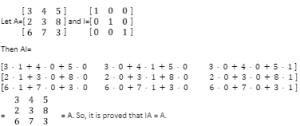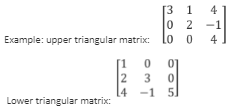In mathematics, matrices are tables of various sets of numbers, symbols, or expressions arranged in rows and columns and represent a particular mathematical expression or object of such a specific object. The numbers which are representing the matrix are called elements of the matrix.
The calculation of matrices, like the multiplication of matrices, depends on various arithmetic laws. So to work with matrices and decode them, you need to follow some rules that will make the calculation easy and effective.
Multiplication of Matrices.
Of all the calculations that can be done with matrices, multiplication is one of the operations that can be done in linear algebra. Multiplication of matrices are binary operations, and it gives one matrix as the answer from two matrices. Multiplication between two matrices is possible when both the matrices are compatible.
What are the major types of matrices?
To work effortlessly with matrices, you need to know the various types of matrices you will be working with to solve a problem.
Row matrix: This possesses a single row. Example:
Column matrix: This possesses a single column. Example:
Null matrix: In this, all the entries or elements are zero. Example: ( 0 0 ) or .
Null matrices possessing all the elements 0 can be denoted by 0.
Square matrix: A square matrix is also called an n x n matrix where rows and columns are all the same.
A diagonal matrix is a square matrix where the elements present are all zeros except those on the main diagonal.
Scalar matrix: In this type of matrix, all the elements present on the diagonal are the same or equal to each other.
Unit matrix: In this type of matrix, all the elements present on the diagonal equal 1. It is also called an identity matrix. In the unit matrix, if matrix A is a square matrix of the order n and matrix I am a unit matrix of the order n, then we can say that AI = IA = A.

Triangular matrix: In this matrix type, all the elements above or below the diagonal are always zero. There are two variants of triangular matrices called the upper triangular matrix and a lower triangular matrix.
Symmetric matrix: This type of matrix is equivalent to the transpose of the matrix. So matrix A is equal to the transpose of matrix A ( A = Aᵀ ).
Skew-symmetric matrix: Here, the transpose of the matrix is equivalent to the negative of the original matrix. So if we take matrix A, its transpose is equal to negative matrix A ( Aᵀ= -A ).
How to multiply matrices?
The basic method that we all will come across for the multiplication of matrices involves multiplying the first row by the columns, and accordingly, the rows are filled up. Some of the major rules to follow while working with matrices are listed below.
- Check the compatibility of the matrices. To do so, you have to check that the number of columns in the first matrix is equivalent to the number of rows in the second matrix.
- For easy multiplication of matrices, multiply the Nth row of the first matrix with the Mth column of the second matrix and add the products.
- Next, place the added results in the respective correct positions.
Explanation:
Aspects of 2×2 matrix multiplication.
The multiplication process of a 2×2 matrix is quite similar to the previously shown examples. Here also, the elements of each row of the first matrix will be multiplied by each of the columns of the second matrix. Finally, the products will be added and represented correctly as the answer.
![]()
Aspects of 3×3 matrix multiplication.
As the number of entries increases in the multiplication of matrices, the complexity also increases. But with concentration and a clear concept, one can easily decode it and get the correct answer. With 3×3 matrix multiplication, the process is the same as the multiplication of any order matrix. The product here will be a 3×3 matrix only.
Rules of matrix multiplication.
A few rules have been formulated to make the entire process of multiplication of matrices easier. These help us solve matrices in linear algebra and should be kept in mind to solve them effortlessly. The rules are stated as a given blow,
- Non-commutative rule: The multiplication of matrices is non-commutative. This means the result of the multiplication of two matrices, X and Y, will be XY≠YX.
- Distributivity rule: if matrices A B and C are compatible, A(B+C)= AB + BC.
- Scalar product rule: if the product of matrices J and K is JK and it is defined, then, c(JK) = (JC)K = J(Kc), here c is considered a scalar.
- Transpose rule: the transpose of the matrices C and D product can be written a
(CD) ᵀ= DᵀCᵀ , ᵀ denotes the transpose.
- Complex conjugate rule: (AB)*=B*A*
- Associativity rule: given three matrices X Y and Z and the precuts (XY)Z and X(YZ) are defined, then we can say (XY)Z= X(YZ).
Conclusion:
Working with matrices might look overwhelming in the beginning due to the involvement of so many numbers and rules. But with proper practice and clear concepts, they can be easily solved within time. Firstly study the rules and concepts and then check out as many examples possible before solving; this will help ge
 Profile
Profile Settings
Settings Refer your friends
Refer your friends Sign out
Sign out








